Odisha State Board CHSE Odisha Class 12 Biology Solutions Chapter 2 Sexual Reproduction in Flowering Plants Textbook Questions and Answers.
CHSE Odisha 12th Class Biology Chapter 2 Question Answer Sexual Reproduction in Flowering Plants
Sexual Reproduction in Flowering Plants Class 12 Questions and Answers CHSE Odisha
Very Short Answer Type Questions
Fill in the blanks with correct answer from the choices given in the bracket
Question 1.
When gynoecium matures first it is called ………… to effect cross-pollination. (protogyny, protandry, herkogamy, unisexuality)
Answer:
protogyny
Question 2.
In ornithophily, the agents for cross-pollination are ………….. . (ants, birds, snails, rats)
Answer:
birds
Question 3.
Zygote develops from …………. cell of the embryo sac. (egg, synergid, antipodal, nucellus)
Answer:
egg
Question 4.
Fertilisation was discovered by …………. (Strasburger, Mendel, Nitsch, Bower)
Answer:
Strasburger
Question 5.
Due to triple fusion, ……….. is formed.
(zygote, embryo, endosperm, zoospore)
Answer:
endosperm
Question 6.
The innermost layer of wall layers is ………….. (tapetum, epidermis, endodermis, endothecium)
Answer:
tapetum
![]()
Question 7.
Straight ovules are called ……………… (anatropous, campylotropous, orthotropous, hemitropous)
Answer:
orthotropous
Question 8.
Contrivance of self-pollination is ………….. (dicliny, herkogamy, self-sterility, cleistogamy)
Answer:
cleistogamy
Answer each of the following in one word or more words
Question 9.
Androecium and gynoecium whorls are present in the same flower.
Answer:
Bisexual flower
Question 10.
Both the essential whorls are absent in a flower.
Answer:
Neuter flower
Question 11.
Petals are united in a flower.
Answer:
Gamopetalous
Question 12.
Free carpels in a flower.
Answer:
Apocarpous
Question 13.
Transfer of pollen grains from anther to stigma of the same flower.
Answer:
Self-pollination
Question 14.
The process in which the’male gamete fertilises with egg.
Answer:
Fertilisation
Question 15.
Pollination in aquatic plants.
Answer:
Hydrophily
Question 16.
Fusion of one male gamete with definitive nucleus.
Answer:
Triple fusion
![]()
Correct the statements without changing underlined words only
Question 17.
Anemophilous flowers are pollinated by ants.
Answer:
Anemophilous flowers are pollinated by wind.
Question 18.
Dichogamy is found in bisexual flowers where stamens and carpels mature at same time.
Answer:
Dichogamy is found in bisexual flowers where stamens. and carpels mature at different time.
Question 19.
The ovule is attached to the placenta of ovary by means of nucellus.
Answer:
The ovule is attached to the placenta of ovary by means of a stalk called funiculus.
Question 20.
Animals acting as agents of pollination are called anemophily.
Answer:
Animals acting as agents of pollination are called zoophily.
Question 21.
Polyembryony involves development of one embryo.
Answer:
Polyembryony involves development of more than one embryo from a single fertilised ovum.
Fill in the blanks
Question 22.
The cells present on two sides of egg in the egg apparatus are called ……………..
Answer:
synergids
Question 23.
The outer wall of the pollen grain is called …………..
Answer:
exine
Question 24.
The male gametes are formed from …………. cell.
Answer:
generative
Question 25.
Parthenogenesis means development of fruits without ……………….
Answer:
fertilisation
Question 26.
The endosperm in which first division is cellular and subsequential cellular is called ……………… endosperm.
Answer:
cellular
![]()
Question 27.
In grafting, the part of the plant detached is called ………….
Answer:
scion
Question 28.
In self-pollination, pollen is transferred to stigma of the ………….. flower.
Answer:
same
Question 29.
The fertile cells from which microspores or megaspores developed are called ………….. cells.
Answer:
diploid mother
Question 30.
In maize plant, male inflorescence is borne at portion of the plant.
Answer:
tassel
Question 31.
The fusion product of male gamete and egg cell in angiosperms form …………….
Answer:
zygote
Short Answer Type Questions
Write notes on the following with at least 2 valid points
Question 1.
Parthenogenesis
Answer:
The word parthenogenesis is derived from two Greek words, parthenos means ‘virgin’ and genesis means ‘origin’. It can be defined as the formation of embryo from an unfertilised egg or female gamete. In plants, parthenogenesis is a component process of apomixis.
In parthenogenesis, the haploid egg in which no ‘ fertilisation occurs, develop into an embryo. This forms – viable seed which can give rise to a new plant. In , contrast, in parthenocarpy if seeds develop, they are abortive and do not give rise to new plants.
Question 2.
Allogamy
Answer:
Cross-pollination is also called allogamy. It is the transfer of pollen grains from anther of flower to stigma of flower on another plant of same or allied species.
Question 3.
Herkogamy
Answer:
Herkogamy is seen in orchids where male or female sex organs themselves prove as a barrier to prevent self-pollination by some structural abnormalities.
Question 4.
Geitonogamy
Answer:
It is a kind of pollination where the pollen grains from the anther of a flower are transferred to the stigma of another flower borne on the same plant but at different branches. It usually occurs in plants which show monoecious condition, e.g. Cucurbita. It is functionally a type of cross-pollination (involving a pollinating agent), but genetically it is similar to autogamy (since pollen grains come from same plant).
Adaptations (Contrivances) for Self-Pollination
The contrivances of self-pollination include homogamy, dichogamy and cleistogamy.
- Homogamy In this condition, both anther and stigma mature at the same time, e.g. Mirabilis.
- Dichogamy In this condition, anther and stigma mature at different times, e.g. sunflower.
- Cleistogamy The flowers which are always closed are known as deistogamous, e.g. Oxalic
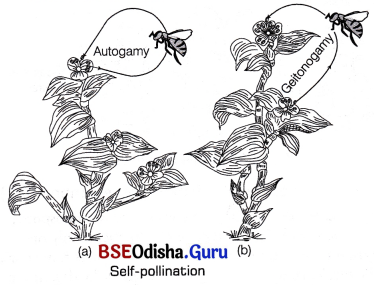
![]()
Advantages of SeLf-PoLlination
- Fertilisation and production of the progeny are always certain by this method.
- It maintains purity of race and superiority of the variety.
- Here there is less wastage of pollens.
Disadvantages of SeLf-Pollination
- It leads to loss of viability and vigour of the plant in the long run.
- If lethal genes become homozygous, the effect may be disastrous.
![]()
Question 5.
Xenogamy
Answer:
Cross-pollination within a species (different variety) is called xenogamy and it results in production of hybrids.
Question 6.
Self-sterility
Answer:
Self-incompatibility or Self-sterility is the third device to prevent inbreeding. It is a genetic phenomenon of preventing the pollen from fertiismg ovules by the same flower by inhibiting pollen germination or pollen tube growth în the pistil.
Self-incompatibility may be due to genotype of sporophyte known as sporophytic incompatability whereas if it is due to genotype of pollen, it is known as gametophytic incomparibility.
Question 7.
Entomophily
Answer:
Pollination taking place under water is known as hypohydrogamous whereas pollination taking place on surface of water is cailed epihydrogamous.
Question 8.
Embryo sac
Answer:
Embryo sac refers to female gametophyte of a plant.
Organisation of Female Gametophyte (Embryo Sac)
In general, the development of embryo sac is monosporic, e.g. in Polygonum. In this type of development, only one megaspore situated towards chalazal end remains functional, while the remaining three megaspores gradually degenerate and finally disappear. Following are the different stages in development of female gametophyte
- The functional haploid megaspore is the first cell of female gametophyte of angiosperm.
- It enlarges in size to form the female gametophyte, also called embryo sac.
- Its nucleus undergoes mitotic division to form 2-nuclei that move to opposite poles forming 2-nucIeate embryo sac.
- The 2-nucleate embryo sac undergoes two more sequential mitotic divisions giving rise to the 4-nucleate stage and later 8-nucleate stage of embryo sac. This stage comprises of a micropylar end and a chalazal end with four nuclei at each end.
- Six of the eight nuclei are surrounded by cell walls and get organised into cells. Three cells present towards the micropylar end grouped together, constitute the egg apparatus, i.e. two synergids and one egg cell.
- Three cells of the chalazal end are called the antipodals. The large central cell is formed by the fusion of 2-polar nuclei. Thus, a typical angiospermic embryo sac or female gametophyte at maturity consists of 8-nuclei and 7-cells.
The egg cell combines with a male gamete to form zygote which becomes the embryo. The pollen tube makes its way through the synergids releasing the male gametes.
One male gamete fuses with female gamete (egg) called syngamy. The two polar nuclei which have fused to form secondary nucleus combine with second male gamete and form primary endosperm cell. This primary endosperm cell develops into endosperm which provides nutrition to the developing embryo. The antipodal cells degenerate.
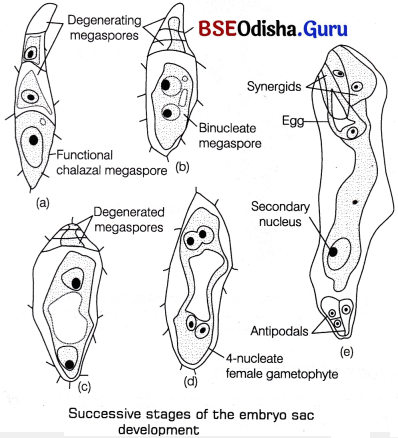
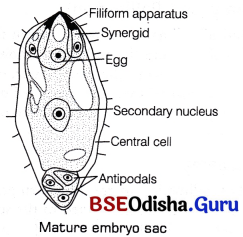
Question 9.
Embryo
Answer:
Development of an Embryo: The first stage in the development of a plant zygote is a pre-determined mode of development (embryogeny).
It gives rise to an organised mass of cells called the embryo, that has the potentiality to form a complete plant. Most zygotes divide only after certain amount of endosperm is formed to assure proper nutrition is provided to the developing embryo.
In the majority of angiosperms, the zygote (fertilised egg) divides by an asymmetric mitotic division and generates two cells with two different fates
- The smaller daughter cell with dense cytoplasm is situated towards the chalazal pole side. It is called terminal cell or apical cell or embryonal cell.
- Another comparatively larger daughter cell situated towards the micropylar cell is called basal cell. This cell divides transversely and gives, rise to suspensor cells. The zygote gives rise to the proembryo anti subsequendy to the globular, heart-shaped and mature embryo.
Though the seeds differ greatly, the early stages of embryo development (embryogeny) are similar in monocots and dicots.
Question 10.
Micropropagation
Answer:
Micropropagation It is the production of large number of individual plants from a small piece of plant tissue cultured in a nutrient medium. It leads to formation of clones. It is a fast method of plant production.
Question 11.
Polyembryony
Answer:
Polyembryony
In general, each seed bears an embryo, but sometimes there are found more than one embryo in a single seed. The occurrence of more than one embryo in a seed is called polyembryony. It was first time observed in orange seeds by Antony van Leeuwenhoek in 1719.
On a broad basis, polyembryony is of two types
- Spontaneous It includes naturally occurring polyembryony.
- Induced This type of polyembryony is induced experimentally.
Question 12.
Incompatibility
Answer:
Incompatibility It is the inability of the pollen grains to germinate on the stigma of genetically similar plants or the failure of gametes to fuse or inability of the zygote to develop into a mature sporophyte.
![]()
Differentiate the following with at least three valid and meaningful points.
Question 1.
Pollination and Fertilisation.
Answer:
Differences between pollination and fertilisation are as follows
| Pollination | Fertilisation |
| It refers to the transfer of pollen grains from an anther to stigma. | It refers to the fusion of male and female |
| It is a physical process. | It is cellular, genetic, biochemical process. |
| It can be achieved by various agents such as wind, insect, etc. | It is assisted by the plant itself. |
Question 2.
Dichogamy and Herkogamy.
Answer:
Differences between dichogamy and herkogamy are as follows
| Dichogamy | Herkogamy |
| When stamens and carpels of bisexual flowers mature at different times to prevent self-pollination, it is called dichogamy. | When some sort of barrier develops between stamens and pistil of same flowers and prevents self-pollination, it is called herkogamy. |
| It is of two types, i.e. protogyny and protoandry. | It is seen in Calotropis, etc. |
| It is seen in banana, coriander, etc. | It also prevents cross-pollination. |
| It prevents self-pollination. | Herkogamy |
Question 3.
Protogyny and Protandry.
Answer:
Differences between protogyny and protandry are as follows
| Protandry | Protogyny |
| In this, the anthers mature earlier so that its stigma is not ready to receive pollen from its anther. | In this, stigmas mature earlier so that they get pollinated before the anthers of the same flower mature and develop pollen grains. |
| e.g. in Salvia, sunflower, cotton, jasmine, etc. | e.g. in Plantago, Mirabilis jalapa, peepal, banyan, etc. |
Question 4.
Self-pollination and Cross-pollination.
Answer:
Differences between self-pollination and cross-pollination are as follows
| Self-pollination | Cross-pollination |
| Pollen grains are transferred from anther to stigma of the same flower (autogamy) or another flower borne on the same plant (geitonogamy). | Pollen grains are transferred from anther of one flower to stigma of another flower borne on a different plant of the same species (allogamy). |
| Both anthers and stigma mature at the same time. | The anthers and stigma of a flower mature at different times. |
| External agent is not required for self-pollination. | An external agent is essential for cross-pollination. |
| It is economical for the plant. | Cross-pollination is not economical as the plant has to produce a large number of pollen grains, nectar, ‘ scent and bright coloured corollas, etc. |
| It results in progenies which are purelines, e.g. homozygous. | It results in hybrids, e.g. heterozygous. They show variations in characters. |
![]()
Question 5.
Embryo and Endosperm.
Answer:
Differences between embryo and endosperm are as follows
| Embryo | Endosperm |
| It is formed by fertilised egg. (syngamy). | It is formed by fusion of secondary nucleus (triple fusion). |
| It is always diploid. | It is triploid. ‘ |
| It gives rise to new plant. | It provides nutrition to the developing embryo. |
| Cotyledons, plumule and radicle are formed in embryo. | There is no formation of such structures. |
| Embryo is seen in seed. | It is only seen in endospermic seeds. Otherwise it degenerates with the formation of seed. |
Question 6.
Gamete and Zygote.
Answer:
Differences between gamete and zygote are as follows
| Gamete | Zygote |
| It is the cell that fuses with another cell in order to form zygote during fertilisation, | It is the fused product between an egg and a sperm. |
| Ploidy level of gametes is haploid. | Ploidy level of zygote is diploid. |
| Gamete is found in both male and female. | Zygote is only present in female. |
Question 7.
Micropyle end and Chalazal end.
Answer:
Differences between micropyle end and chalazal end are as follows
| Micropyle end | Chalazal end |
| In seed bearing plants, a small opening in the integuments of the ovule through which sperms are able to access the ovum. | In seed bearing plants, the location where the nucellus attaches to the integuments, opposite the micropyle. |
Question 8.
Zoophily and Anemophily.
Answer:
Differences between zoophily and anemophily are as follows
| Zoophily | Anemophily |
| Animal pollination is termed as zoophily. These animals can be bats, insects, birds, ants, etc. | Wind pollination is also termed as anemophily. |
| These flowers are large, colourful, fragrance and rich in nectar. | These flowers are small, colourless, inconspicuous and nectarless. |
| The pollen grains are produced in less number. | The pollar grains produced are more in number. |
Question 9.
Double fertilisation and Triple fusion.
Answer:
Differences between double fertilisation and triple fusion are as follows
| Double fertilisation | Triple fusion |
| It involves two processes, i.e. triple fusion and syngamy. | It is a process in angiosperms which occurs along with syngamy in the embryo. |
| It involves two sperm cells or male gametes. | It involves a single male gamete. |
| After double fertilisation zygote and an endosperm is formed. | It involves fusion of a male gamete with polar nuclei to form triploid endosperm. |
Question 10.
Porogamy and Chalazogamy
Answer:
Differences between porogamy and chalazogamy are as follows
| Porogamy | Chalazogamy |
| It is the condition when the pollen tube enters the ovule from the micropylar end during fertilisation. | It is the condition of entering of pollen tube from chalazal end during fertilisation. |
| e.g. in lily, etc. | e.g. in Casuarina, Jug Ians, etc. |
Question 11.
Apospory and Apogamy.
Answer:
Differences between apospory follows and apogamy are as
| Apospory | Apogamy |
| It is a type of reproduction in which gametophyte develops from sporophyte without meiosis and involvement of spores. The gametophyte usually develops from vegetative cells of sporophyte. | It is a type of reproduction in which sporophyte develops from gametophyte without fertilisation or fusion of gametes. The sporophyte usually develops from vegetative cells of gametophyte. |
![]()
Question 12.
Monocot and Dicot embryo.
Answer:
Differences between monocot and dicot embryo are as follows
| Monocot embryo | Dicot embryo |
| Basal cell forms a 6-10 celled suspensor. | Basal cell produces a single-celled suspensor. |
| Terminal cell produces embryo except the radicle. | It forms the whole of the embryo. |
| The first division of terminal cell is generally longitudinal. | It is transverse. |
| It has two cotyledons. | There is a single cotyledon. |
| Plumule is terminal and lies in between the two elongated cotyledons. | Plumule appears lateral due to excessive growth of the single cotyledon. |
Question 13.
Nuclear and Cellular endosperm. (2018)
Answer:
Differences between nuclear and cellular endosperm are as follows
| Nuclear endosperm | Cellular endosperm |
| Nuclear divisions are not followed by cell divisions. | Each division of nuclei is immediately followed by cell divisions. |
| The nuclear mass is then pushed to periphery and cell walls are laid. Mostly cell wall formation remains incomplete. | Complete cell walls are laid from the very beginning and a solid cellular mass is obtained, |
| A central vacuole is formed initially which ultimately disappears with a few exceptions. | No such vacuole is formed generally. |
| e.g. wheat, maize, rice, etc. | e.g. balsam, Datura, Petunia, etc. |
Long Answer Type Questions
Question 1.
Distinguish between self and cross-pollination. Describe three conditions that favour cross-pollination.
Answer:
1. Autogamy (Self-Pollination)
It is the kind of pollination achieved within the same flower. The pollens from the anthers of a flower are transferred to the stigma of the same flower, e.g. wheat, rice, pea, etc., almost all the cleistogamous flowers are invariably autogamous as there is no chance of cross-pollination.
2. Geitonogamy
It is a kind of pollination where the pollen grains from the anther of a flower are transferred to the stigma of another flower borne on the same plant but at different branches. It usually occurs in plants which show monoecious condition, e.g. Cucurbita. It is functionally a type of cross-pollination (involving a pollinating agent), but genetically it is similar to autogamy (since pollen grains come from same plant).
Adaptations (Contrivances) for Self-Pollination The contrivances of self-pollination include homogamy, dichogamy and cleistogamy.
- Homogamy In this condition, both anther and stigma mature at the same time, e.g. Mirabilis.
- Dichogamy In this condition, anther and stigma mature at different times, e.g. sunflower.
- Cleistogamy The flowers which are always closed are known as cleistogamous, e.g. Oxalis.

Self-pollination
Advantages of Self-Pollination
- Fertilisation and production of the progeny are always certain by this method.
- It maintains purity of race and superiority of the variety.
- Here there is less wastage of pollens.
Disadvantages of Self-Pollination
- It leads to loss of viability and vigour of the plant,in the long run.
- If lethal genes become homozygous, the effect may be disastrous.
3. Xenogamy (Cross-Pollination)
It involves the transfer of pollen grains from the anther of one plant to the stigma of another plant. This is the only type of pollination which brings genetically different types of pollen grains to the stigma during pollination, e.g. papaya, maize, etc.
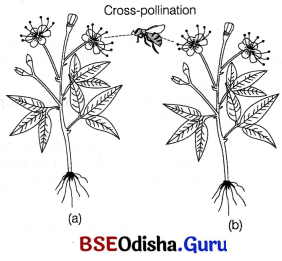
Advantages of Cross-Pollination
- This always results in much healthier offsprings.
- The offsprings produced in this method are better adapted ones.
- As a result of the cross-pollination, hybrids are produced.
- More abundant and viable seeds are produced which store greater quantities of food material.
- The process eliminates defective characters and is helpful in production of new varieties.
Disadvantages of Cross-Pollination
- This is wasteful process, as large number of pollen grains get damaged in the course of pollination.
- The chance of fertilisation is limited here since it can be affected only if the pollen reaches the matured stigma.
Adaptations (Contrivances) for Cross-Pollination or Outbreeding Devices
Continued self-pollination leads to chances of inbreeding depression. Thus, flowering plants have developed many devices to discourage self-pollination and to encourage cross-pollination. These include
1. Dichogamy In some plant species, receptivity of stigma and pollen release is not synchronised, i.e. often the pollen is released before the stigma becomes receptive (protandry) or stigma becomes receptive before the release of pollen (protogyny). This condition is called dichogamy.
2. Heterostyly In some other species, the anther and stigma are placed at different positions, so that the pollen cannot come in contact with the stigma of same flower. This condition is called heterostyly.
Both the above mentioned methods will prevent autogamy.
3.Self-incompatibility or Self-sterility is the third device to prevent inbreeding. It is a genetic phenomenon of preventing the pollen from fertilising ovules by the same flower by inhibiting pollen germination or pollen tube growth in the pistil. Self-incompatibility may be due to genotype of sporophyte known as sporophytic incompatibility, whereas if it is due to genotype of pollen, it is known as gametophytic incompatibility.
4.Dicliny or Unisexuality effectively prevents self-pollination. It is the presence of unisexual flowers in plants that prevents autogamy but not geitonogamy, e.g. castor, maize, etc.
5.Herkogamy is seen in orchids where male or female sex organs themselves prove as a barrier to prevent self-pollination by some structural abnormalities.
6.Dioecy Both autogamy and geitonogamy is prevented in several species like papaya, where male and female flowers are present on different plants, i.e. each plant is either male or female (dioecy).
![]()
Question 2.
What is cross-pollination? Give an account of the contrivances of cross-pollination.
Answer:
Xenogamy (Cross-Pollination)
It involves the transfer of pollen grains from the anther of one plant to the stigma of another plant. This is the only type of pollination which brings genetically different types of pollen grains to the stigma during pollination, e.g. papaya, maize, etc.

Advantages of Cross-Pollination
- This always results in much healthier offsprings.
- The offsprings produced in this method are better adapted ones.
- As a result of the cross-pollination, hybrids are produced.
- More abundant and viable seeds are produced which store greater quantities of food material.
- The process eliminates defective characters and is helpful in production of new varieties.
Disadvantages of Cross-Pollination
- This is wasteful process, as large number of pollen grains get damaged in the course of pollination.
- The chance of fertilisation is limited here since it can be affected only if the pollen reaches the matured stigma.
Adaptations (Contrivances) for Cross-Pollination or Outbreeding Devices
Continued self-pollination leads to chances of inbreeding depression. Thus, flowering plants have developed many devices to discourage self-pollination and to encourage cross-pollination. These include
1. Dichogamy In some plant species, receptivity of stigma and pollen release is not synchronised, i.e. often the pollen is released before the stigma becomes receptive (protandry) or stigma becomes receptive before the release of pollen (protogyny). This condition is called dichogamy.
2. Heterostyly In some other species, the anther and stigma are placed at different positions, so that the pollen cannot come in contact with the stigma of same flower. This condition is called heterostyly.
Both the above mentioned methods will prevent autogamy.
3.Self-incompatibility or Self-sterility is the third device to prevent inbreeding. It is a genetic phenomenon of preventing the pollen from fertilising ovules by the same flower by inhibiting pollen germination or pollen tube growth in the pistil. Self-incompatibility may be due to genotype of sporophyte known as sporophytic incompatibility, whereas if it is due to genotype of pollen, it is known as gametophytic incompatibility.
4.Dicliny or Unisexuality effectively prevents self-pollination. It is the presence of unisexual flowers in plants that prevents autogamy but not geitonogamy, e.g. castor, maize, etc.
5.Herkogamy is seen in orchids where male or female sex organs themselves prove as a barrier to prevent self-pollination by some structural abnormalities.
6.Dioecy Both autogamy and geitonogamy is prevented in several species like papaya, where male and female flowers are present on different plants, i.e. each plant is either male or female (dioecy).
Question 3.
Describe how different agents help in cross-pollination.
Answer:
Agents of Cross-Pollination
The agents responsible for pollination in angiospermshave been grouped into two main categories
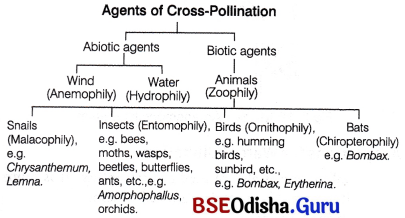
To compensate for the chances of contact of pollen grains with stigma and associated loss of pollen grains, the plants have adopted various ways.
Some of them are
Adaptations for Wind Pollination
Wind pollination is also termed as anemophily and is the most common amongst abiotic pollinations.
The adaptations of wind pollinated flowers are
- Flowers are small, colourless, inconspicuous and nectarless.
- Wind pollinated flowers often have a single ovule in each ovary and numerous flowers packed into an inflorescence like in tassels of corn cob (i.e. stigma and style).
- The anthers are well-exposed for the easy dispersal of pollen grains.
- Pollen grains are small, light, dry, dusty, non-sticlcy and sometimes even winged.
- The stigma are large, hairy and feathery or branched to catch the air-borne pollen grains.
- Common examples of wind pollinated flowers are grasses, sugarcane, bamboo, coconut, etc.
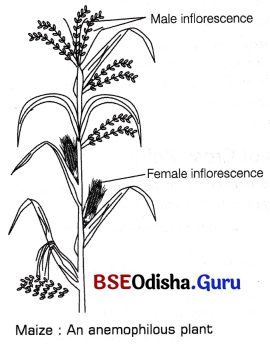
Adaptations for Water Pollination
Water pollination is also termed as hydrophily. It is quite rare in flowering plants and is limited to about 30 genera, mostly monocotyledons.
The adaptations of water pollinated flowers are
- It is very common in lower plant groups such as algae, bryophytes and pteridophytes. Flowers are small, colourless, inconspicuous, odourless and nectarless.
- The stigmas are long and sticky, e.g. Vallisneria, Hydrilla and Zostera (sea-grasses).
- In most of the water pollinated species, pollen grains are protected from getting wet by mucilaginous covering.
- Not all aquatic plants use water for pollination. In a majority of aquatic plants, the flowers emerge above the level of water and are pollinated by insects or wind as in land plants, e.g. water hyacinth and water lily.
- In Vallisneria, the female flowers reach the surface of water by the long stalk and male flowers or pollen grains are released on to the surface of water. They are then carried passively by water currents.
- In plants like sea grasses, female flowers remain submerged in water and the pollen grains are released inside the water. In such species, pollen grains are long, ribbon-like and are carried passively inside the water to reach stigma and achieve pollination.
- Pollination taking place under water is known as hypohydrogamous whereas pollination taking place on surface of water is called epihydrogamous.
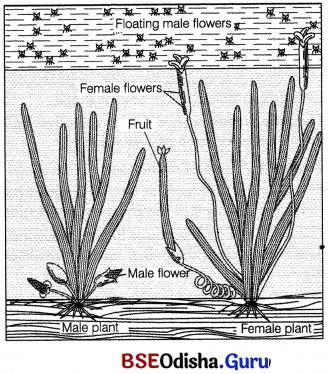
Adaptations for Insect Pollination
Insect pollination is also termed as entomophily.
The adaptations of insect pollinated flowers are
- Insect pollinated flowers are large, colourful, fragrant and rich in nectar.
- A number of flowers are clustered into an inflorescence to make them conspicuous, when the .flowers are small.
- Flowers have nectar glands and are highly fragrant to attract insects.
- The surface of pollen grains is sticky due to exine layer and stigma is sticky due to mucilaginous layer.
- To sustain animal visits, flowers have to provide rewards. Nectar and pollen grains are floral rewards for the insect pollinators.
- In some species, floral rewards are to provide safe place for laying eggs, e.g. Amorphophalius (the tallest flower abput 6 feet in height).
- In plant Yucca, moth and the plant cannot complete their life cycles without each other. The moth deposits its eggs in the locule of the ovary and the flower, in turn, gets pollinated by the moth. The larvae of the moth come out of the eggs as the seeds start developing.
- Many insects may consume pollen or the nectar without bringing about pollination. These floral visitors are referred to as pollen/nectar robbers.
Some special mechanisms in case of insect pollination are as follows
- In case of Bignonia where the stigma gets exposed by opening the flap closed by visit of insect.
- In hypanthodium inflorescence, the insects enter through ostiole which is a pore which opens the inflorescence to outside.
In this inflorescence, three types of flowers occur. The insect when visits, it passes through anthers of male flowers and then reaches female flowers which are present in middle part of inflorescence. This results in pollination. - Another adaptation occurs in Salvia where there is the presence of a bilabiate corolla with two epipetalous stamens.
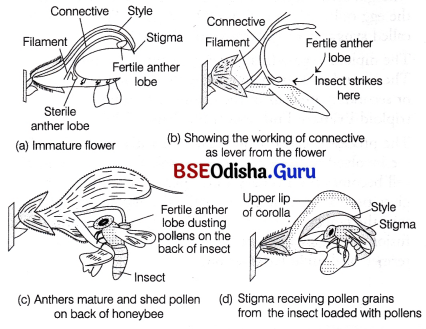
Insect pollination in Salvia-, (a) A structure of flower, (b) Diagrammatic representation of changes taking place in the position of anther lobes during the entry of insect in the flower, (c) Entry of insect in the flower [note the dusting of pollen grains on the back of the insect], (d) Insect entering another flower and the pollens on its back being collected by stigma
![]()
Question 4.
Discuss the important outbreeding devices for cross-pollination.
Answer:
Adaptations (Contrivances) for Cross-Pollination or Outbreeding Devices
Continued self-pollination leads to chances of inbreeding depression. Thus, flowering plants have developed many devices to discourage self-pollination and to encourage cross-pollination. These include
1. Dichogamy In some plant species, receptivity of stigma and pollen release is not synchronised, i.e. often the pollen is released before the stigma becomes receptive (protandry) or stigma becomes receptive before the release of pollen (protogyny). This condition is called dichogamy.
2. Heterostyly In some other species, the anther and stigma are placed at different positions, so that the pollen cannot come in contact with the stigma of same flower. This condition is called heterostyly.
Both the above mentioned methods will prevent autogamy.
3.Self-incompatibility or Self-sterility is the third device to prevent inbreeding. It is a genetic phenomenon of preventing the pollen from fertilising ovules by the same flower by inhibiting pollen germination or pollen tube growth in the pistil. Self-incompatibility may be due to genotype of sporophyte known as sporophytic incompatibility, whereas if it is due to genotype of pollen, it is known as gametophytic incompatibility.
4.Dicliny or Unisexuality effectively prevents self-pollination. It is the presence of unisexual flowers in plants that prevents autogamy but not geitonogamy, e.g. castor, maize, etc.
5.Herkogamy is seen in orchids where male or female sex organs themselves prove as a barrier to prevent self-pollination by some structural abnormalities.
6.Dioecy Both autogamy and geitonogamy is prevented in several species like papaya, where male and female flowers are present on different plants, i.e. each plant is either male or female (dioecy).
Question 5.
Describe how double fertilisation and triple fusion occur in the angiosperms.
Answer:
Double Fertilisation
Fertilisation was discovered by Strasburger. But the process of double fertilisation was demonstrated for the first time by Nawaschin in 1898 in Lilium and Fritillaria. The most important and unique characteristic feature of angiosperms is the participation of both male gametes in the act of fertilisation.
The pollen tube releases the two male gametes into the cytoplasm of one of the synergids, then the penetrated synergid starts degenerating. One male gamete fuses With the egg cell to form a diploid(2«) zygote. This process is called syngamy or generative fertilisation.
- The diploid zygote finally develops into’the embryo.
- The second male gamete fuses with the two polar nuclei or secondary nucleus in the central cell to form the triploid Primary Endosperm Nucleus (PEN).
- The process is called triple fusion as three haploid nuclei are involved in the fusion. After triple fusion, the central cell becomes the Primary Endosperm Cell (PEC) which gives rise to the endosperm, while the zygote develops into the embryo. As both the fusions, syngamy and triple fusion, occur in an embryo sac, the phenomenon is termed as double fertilisation.
Question 6.
With diagrams, describe the development of male and female gametophyte in angiosperms.
Answer:
Development of a Male Gametophyte
Microspore is the first cell of male gametophyte. It involves formation of microsporangium and development of male gametophyte at pre-pollination and post-pollination events. The structures are stages which lead to development of male gametophyte are as follows
Stamen:
It is the male reproductive unit of angiosperm.
It consists of two parts
- The long and slender stalk called the filament.
- The terminal generally bilobed structure called the anther.
The anther and filament are connected by a connective.

Structure of an Anther
A typical angiosperm anther is bilobed structure with each lobe having two theca (dithecous) and separated by a longitudinal groove running lengthwise.
In a cross-section, the anther is a four-sided (tetragonal) structure consisting of four microsporangia located at the corners, two in each lobe. Later, the microsporangia develop and become pollen sacs, which are packed with the pollen grains.
Formation of Microsporangium (Pollen Sacs)
A typical microsporangium is surrounded by four wall layers, i.e. the epidermis, endothecium, middle layer and the tapetum. The outer three wall layers are protective in function and help in dehiscence of anther to release pollen grains. Tapetum (innermost layer) nourishes the developing microspores or pollen grains and the cells of tapetum possess dense cytoplasm and generally have more than one nucleus. When the anther is young, a group of compactly arranged homogenous cells called the sporogenous tissue occupies the centre of each microsporangium.
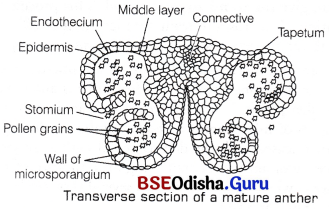
A young anther possesses a homogenous mass of hypodermal cells bounded by epidermis. After some time, this homogenous mass appears like a tetra-angular mass. Inner to this epidermis, some cells at each angle contain a prominent nucleus and abundant protoplasm, they are . called archesporial cells.
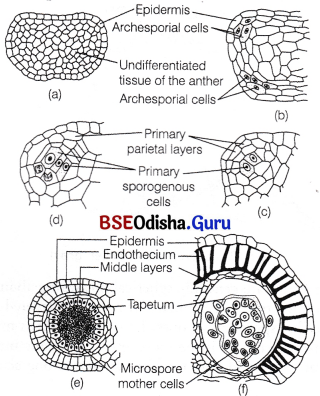
Development of microsporangium (a-e) successive stages of the development of microsporangium, (f) A mature pollen sac in a
Development of a Female Gametophyte:
The process of female gametophyte formation is called megagametogenesis. The process involves pistil which is the female reproductive part.
The stages like development of ovule, megasporogenesis followed by organisation of female gametophyte complete the process.
These structures and stages are discussed as follows
Pistil:
The gynoecium represents the female reproductive part of the flower. It may consist of one pistil or carpel (monocarpellary), two carpels (bicarpellary), three carpels (tricarpellary) or many carpels (multicarpellary). Pistil may be syncarpous (i.e. more than one pistils are fused together) as in Papaver, Solanum, etc., or may be apocarpous (i.e. carpels remain free) as in Michelia, rose, etc.
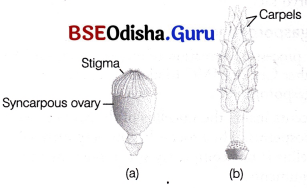
(a) Multicarpellary, syncarpous pistil of Papaver and (b) Multicarpellary, apocarpous gynoecium of Michelia
A typical pistil consists of a hollow basal swollen ovary, an elongated style and a terminal stigma (serves as a landing platform for pollen grains). Inside the ovary is the ovarian cavity (locule) in which placenta is located. Megasporangia (ovules) arise from placenta.
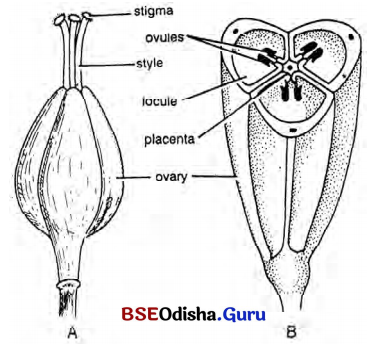
Gynoecium: (A) External view, (B) Transverse section of ovary
The mode of arrangement of ovule along the placenta in the cavity of the ovary is known as placentation (axile, parietal, free-central, etc).
Megasporangium (Ovule):
The ovule is an integumented megasporangium within which the meiosis and megaspore formation take place. It is attached to the placenta by means of a stalk called funicle. It develops into a seed after fertilisation. The junction between an ovule and funicle is called hilum, which later becomes a scar on the seed. Each ovule has one or two protective envelopes called integuments, which encircle the ovule except at a tip where a small opening called micropyle is located.
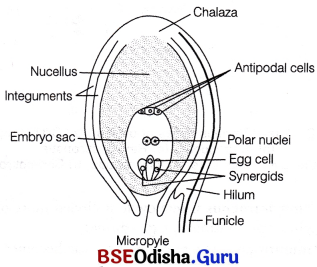
Ovule : Structure tAnatropous ovule
The basal part of an ovule just opposite to micropyle is called chalaza. Enclosed within the integuments is a mass of cells called nucellus. Cells of the nucellus are rich in reserve food materials. An ovule generally has a single embryo sac or female gametophyte developed from a megaspore through reductional division and located within the nucellus.
![]()
Structure of Ovule:
Depending upon the shape and orientation, the ovules of angiosperms are classified into following types
- Orthotropous or atropous where the micropyle, chalaza and funicle are in a straight line, e.g. Piper.
- Anatropous where the body of the ovule is completely inverted, e.g. 82% of angiosperms.
- Hemianatropous where ovule turns at the angle of 90° upon the funicle, e.g. Ranunculus.
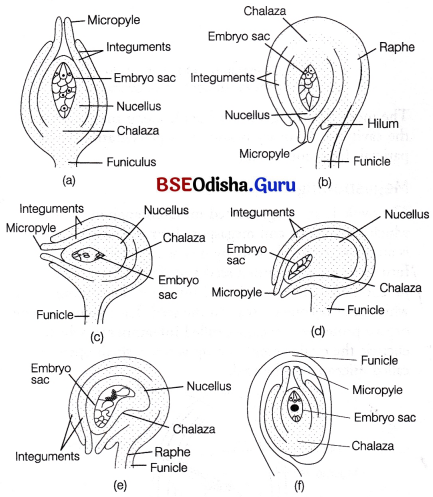
(a-f) Various types of ovules : (a) Orthotropous, (b) Anatropous, (c) Hemianatropous, (d) Campylotropous, (e) Amphitropous, (f) Circinotropous - Campylotropous where ovule is circled more or less at right angle to funicle, e.g. legumes.
- Amphitropous where the embryo sac becomes curved like horse-shoe, e.g. Lemna.
- Circinotropous where funicle completely surrounds the body of the ovule, e.g. Opuntia.
Development of the Ovule:
The development of ovule starts with the formation of a primordium on the placenta first periclinal divisions occur which are followed by anticlinal divisions which cause enlargement of the protruberance. An archesporial cell gets differentiated by acquiring size and dense cell contents. This is followed by initiation of formation of outer and inner integuments.

(A-D) Successive stages in the development , of ovule
These integuments appear as a complete ring and cover the whole nucellus except at the micropylar opening. These integuments enclose the central part of ovule which is a parenchymatous mass of cells. This region gets differentiated to form mature nucellus enclosing a female gametophyte. At the end, the ovule consists of integuments and nucellus which possess embryo sac.
Organisation of Female Gametophyte (Embryo Sac):
In general, the development of embryo sac is monosporic, e.g. in Polygonum. In this type of development, only one megaspore situated towards chalazal end remains functional, while the remaining three megaspores gradually degenerate and finally disappear. Following are the different stages in development of female gametophyte
- The functional haploid megaspore is the first cell of female gametophyte of angiosperm.
- It enlarges in size to form the female gametophyte, also called embryo sac.
- Its nucleus undergoes mitotic division to form 2-nuclei that move to opposite poles forming 2-nucIeate embryo sac.
- The 2-nucleate embryo sac undergoes two more sequential mitotic divisions giving rise to the 4-nucleate stage and later 8-nucleate stage of embryo sac. This stage comprises of a micropylar end and a chalazal end with four nuclei at each end.
- Six of the eight nuclei are surrounded by cell walls and get organised into cells. Three cells present towards the micropylar end grouped together, constitute the egg apparatus, i.e. two synergids and one egg cell.
- Three cells of the chalazal end are called the antipodals. The large central cell is formed by the fusion of 2-polar nuclei. Thus, a typical angiospermic embryo sac or female gametophyte at maturity consists of 8-nuclei and 7-cells.
The egg cell combines with a male gamete to form zygote which becomes the embryo. The pollen tube makes its way through the synergids releasing the male gametes.
One male gamete fuses with female gamete (egg) called syngamy. The two polar nuclei which have fused to form secondary nucleus combine with second male gamete and form primary endosperm cell. This primary endosperm cell develops into endosperm which provides nutrition to the developing embryo. The antipodal cells degenerate.


